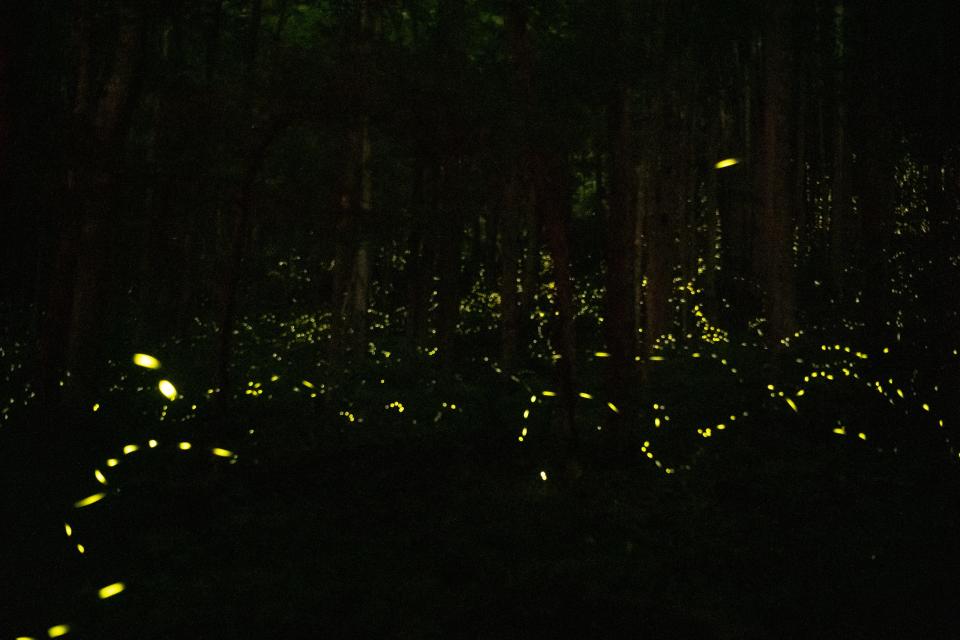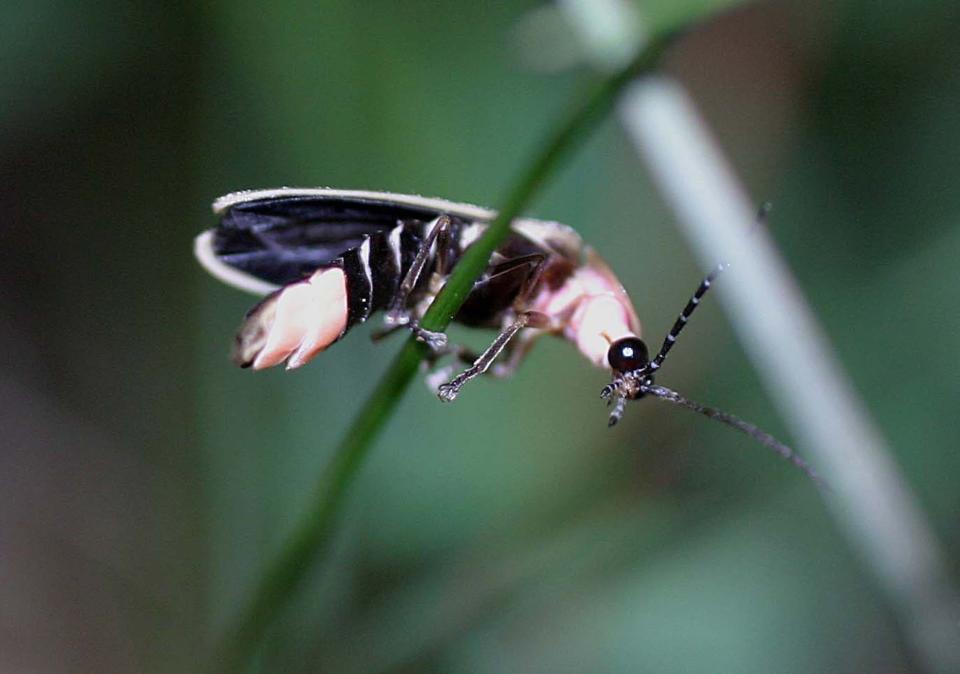Scrub Hub: Are lightning bugs disappearing from Indiana's night skies?
Editor's note: This story was originally published in 2022. We are republishing it as part of our summer coverage.
Chasing lightning bugs on a summer night is a rite of passage for many young Indiana residents.
You know how it goes, pursuing the flickering lights across the dusk sky until you clap your hands in a sphere around one. And then waiting to catch a glimpse of the small flash between your fingers before letting it go again.
In fact, Indiana’s state insect is a lightning bug.
In 2018, after years of campaigning by Hoosier elementary students, the Indiana legislature and Gov. Eric Holcomb proclaimed the Say’s Firefly as the state’s bug. Not only is this species of firefly native to Indiana, it also is named after a Hoosier who discovered it: Thomas Say.
There are about 40 species of what are called Lampyridae, or light-emitting beetles, in Indiana. North America is home to as many as 170 different species and there are more than 1,900 types worldwide. And they've been around for millions of years.
But the flashy beetle — and the pastime of catching them — that once was so commonplace may become a thing of the past.
Lightning bugs or fireflies: What are those glowing insects called?

Many Hoosiers say it feels like they’re seeing fewer flashes across the night sky compared to when they were younger. That’s what our readers want to know: Are lightning bugs disappearing from Indiana?
For this edition of the Scrub Hub, we will be looking at the status of the luminescent beetles across the state and what may be threatening them. We spoke with a couple of experts in the field of bugs to be able to answer these questions and enlighten (too much?) our readers.
Here’s what you need to know.
Short answer: Fireflies are hurting
The lights of fireflies are being snuffed out. At least that’s what the evidence suggests.
“If we go from qualitative assessment alone, they seem to be on the decline,” said Sérgio Henriques. He serves as the Invertebrate Conservation Coordinator for the Indianapolis Zoo’s Global Center for Species Survival.
“If you ask people on the street,” he added, “many people will fondly think of a time when they used to see more and now don’t see as many.”
Part of the problem, however, is that there isn’t great data on lightning bugs — both across the state and the region — to be able to speak quantitatively or with specificity.
Scrub Hub: Are ticks across Indiana getting worse? Should Hoosiers be worried?
Researchers across the country, like Henriques, are trying to change that. They are working to gather more information. There has been a recent and ongoing effort to better grasp populations of lightning bugs, or fireflies, across North America and assess the threat of extinction, he said.
The results of that research were fascinating — if not frustrating.
The fireflies they surveyed fell into three main categories. The first are species that are considered not threatened, and Henriques said there are just a few like that. These are species with a wide geographic range and that alone makes them of lesser concern at the moment.
The second group makes up 40% and includes those fireflies where too little is known about them: “They have been seen so little and reported so infrequently,” Henriques said. While that means they could be doing well, they also could be in such a small pocket that they are on their way out or, worse, are already gone.
The last set is the threatened category. These are the species where there is enough information to know they are on the decline.
The Say’s Firefly, the state insect, falls into the second group, Henriques said. The Cypress firefly, a species recently discovered to be in Indiana, falls into this third category.
“It’s complicated and it depends on the species,” he said. “But overall, they’re not doing great.”
Long answer: Habitat, light pollution and chemicals
There are several reasons why fireflies are at risk, and all are equally troublesome for the charismatic creature.
The first, and an issue that plagues many struggling species, is loss of habitat.
Fireflies do well in areas with some moisture and humidity — they often live near ponds, streams, marshes, rivers and lakes or in the margins where these areas meet fields and forests. However, as the climate continues to change and we have more drought-like conditions, the ecosystems and conditions where they survive are shrinking.
The beetles also are losing their habitat to development. As forested areas or those with tall grasses and native species continue to be lost to buildings, parking lots and perfectly manicured lawns, lightning bugs are left without a home.

Another major reason they are suffering is because of light pollution.
Decades ago, there were not as many lights; lights on streets corners, outsides of homes, etc. While they are good for the safety of cities and roads, not so much for the fireflies.
“That comes at a cost for wildlife that 'sings' with light," Henriques said.
The firefly's light is like a whisper, he said, “while our lights are really loud in comparison and drown them out.”
Fireflies have a pretty short lifespan — just a couple months — and thus a narrow window to reproduce. All the lights at night disorient them and can interfere with their ability to find a mate.
Scrub Hub: Is there a good turf grass replacement that’s dog-friendly and low- or no-mow?
There are a couple species of lightning bugs that do better, though still not well, with light. That includes a species called the Big Dipper, which is what most Hoosiers likely see in their backyards. While they will avoid light where possible, they can tolerate it for a bit longer than most others.
One of the other main threats comes from chemicals: The use of pesticides and herbicides on lawns. While meant for annoying mosquitoes or pesky weeds, those applications can wreak havoc on fireflies in multiple ways
Lightning bug larvae are extremely sensitive, so those chemicals can poison and kill them while they are still in the soil before growing wings. The pesticides can also kill their food — largely slugs and snails and other types of bugs — so they are left with nothing to eat. If the chemicals don’t wipe out their dinner, it gets in their system and effectively poisons the fireflies when they feed.

All these issues are putting fireflies at risk, and to lose them would be a travesty, the experts said.
“What many Hoosiers might not have realized is that when, as children, they witnessed the beauty and magic of this fantastic phenomenon, they were not the first,” Henriques said.
Research estimates that Lampyridae have been around for 100 million years.
“We are today custodians of that beauty and it is our moral role to pass on this legacy for our future generations so that we may enjoy it in the way we’ve enjoyed it.”
Even beyond that beauty, lightning bugs serve critical environmental functions.
They loosen soil, which allows sunlight, oxygen and water to penetrate down below. The beetles also maintain a balance by eating slugs and snails, keeping those critters in check. And they serve an important role in the food chain themselves as grub for spiders and frogs, for example.
Fireflies are a great indicator of environmental health, said Cliff Sadof, a professor of entomology at Purdue University.
“They are an indicator species of the health of the soil system,” he said. “If they are going down, then we need to pay more attention to the health of our soils and the species that rely on them.”

There is an ongoing initiative to better survey and know the extent of lightning populations across both Indiana, the region and the country. Called the Firefly Watch, researchers are asking citizens to follow a procedure that allows them to count the number of fireflies they see over a short period of time.
While this is a simple measure, citizen science efforts like this can help get a broad brush view of what is going on, Sadof said. It can help provide a foundation to help launch more in-depth studies.
“If someone wants to contribute to our understanding of the abundance of fireflies,” he said, “that’s the best way to do it.”
Henriques also said there are “little and easy” things that Hoosiers can do to help lightning bugs across the state. He suggests reducing lights at night, planting native species or installing a rain garden. Another option: reducing the chemicals you use on your yard or in your house.
“Fireflies are a privilege,” he said. “It would be such a waste of a treasure if they were to decline or be gone.”
If you have more questions about beetles, other insects, or any other topics, let us know!
Call IndyStar reporter Sarah Bowman at 317-444-6129 or email at sarah.bowman@indystar.com. Follow her on Twitter and Facebook: @IndyStarSarah. Connect with IndyStar’s environmental reporters: Join The Scrub on Facebook.
IndyStar's environmental reporting project is made possible through the generous support of the nonprofit Nina Mason Pulliam Charitable Trust.
This article originally appeared on Indianapolis Star: Why are lightning bugs are disappearing across Indiana and the US?

 money
money 